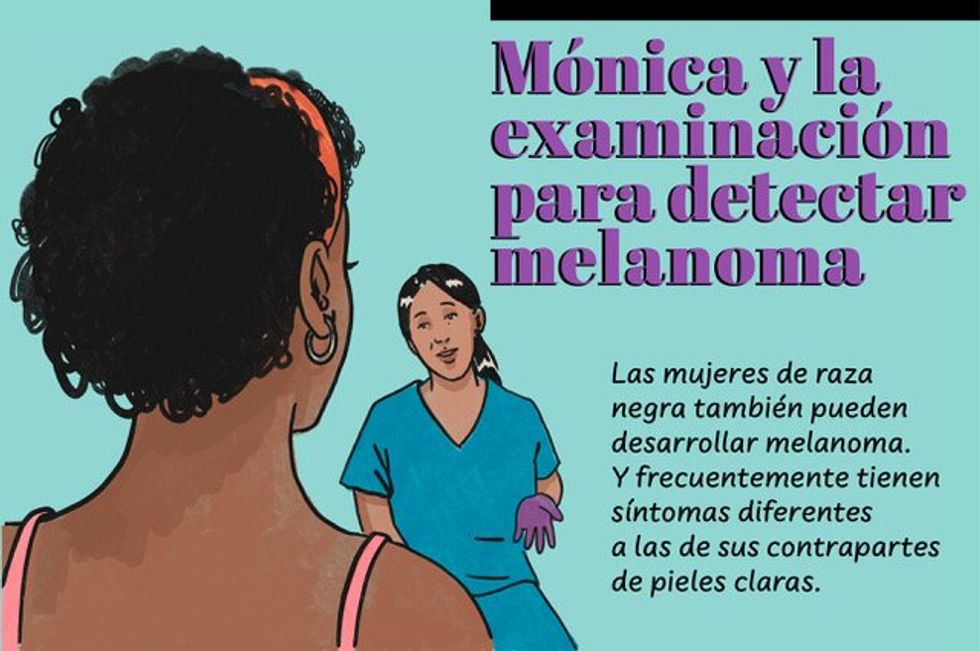

Image
Dialogue
Two black women (Monica and Brandi) are sitting at a table in an outdoor cafe having lunch together and talking.
Monica: What are you going to wear to Stacey’s party next month?
Brandi: Probably a black dress. The one who has the—
Monica: (extends her arm to take her glass of water, exposing a black stain on the palm of her hand)
Brandi: Monica, what is that on your hand?
Monica: This stain? (points to the stain on the palm of his hand) I’m not sure. He appeared there one day. And you know? In fact it’s been bothering me lately. It itches and hurts when I touch it.
Brandi: Have you had her examined?
Monica: No. I’m sure it’s nothing important.
Brandi: It reminds me a little of how Stacey described her skin cancer.
Monica: But she has light skin. People with darker skin like ours don’t have to worry about that. I never get burned.
Brandi: Yeah, but I think you should at least get her checked out.
Monica: Well, I have a dermatologist appointment in a few weeks to try one of those laser skin peel treatments. I’ll mention it then.
Monica is sitting in the examination chair in the dermatologist’s office. They’re just doing one of those fancy laser treatments on his face.
GREAT: A couple of weeks later…
The doctor: We’re done! This should be helpful in combating some of those fine wrinkles you’ve been worrying about.
Monica: Wow, before I left, my friend made me promise to ask you about this stain on my hand. I told him it was nothing, but can you quickly examine it?
Monica’s dermatologist takes a magnifying glass, adjusts his headlamp to illuminate the palm of her hand, leans forward, and examines the mole on the palm of her hand.
Monica’s doctor takes a small sample of the skin from the mole and packages it for a biopsy.
The Doctor: This actually seems a little suspicious.
Monica: Really? What is it?
The doctor: It could be an early stage melanoma
Monica: In the palm of my hand?
The doctor: Yes. In people with darker skin, melanoma actually appears more in areas that don’t get a lot of sun exposure, such as the palms of the hands, soles of the feet, under the nails, and even inside the skin. the mouth
Monica: I didn’t know. I hardly use sunscreen unless I’m at the beach or something because my skin never burns.
The Doctor: Many people of color don’t know that they can also develop skin cancer. And that not all skin cancers are caused by sun exposure. It’s true that people with lighter skin are more at risk, but I also diagnose it in black people, even people who never burn. I’ll ask for a biopsy and call you with the results.
Monica receives a phone call from the doctor.
Monica: Hello?
The doctor: Hello, Monica. Just as I suspected, the mole is an early stage melanoma. The good news is that you showed it to me and we caught it early. I will schedule a consultation for you to come in to remove it.
Monica: Wow. I’m very glad I asked you to look into it.
The doctor: Yes, it’s good that you showed me that mole. Come in for annual exams, monitor your skin between visits, and definitely see if you notice anything else that’s suspicious.
Additionally, even though sun exposure probably did not cause this melanoma, it is important to use sunscreen. Use a sunscreen with SPF 30 or higher. It is best to find a brand with zinc oxide or titanium dioxide. Zinc can leave white traces on your skin, but they make dark-toned protectors for people of color.
Monica: Thank you!
Monica is at Stacey’s party with her friend Brandi. They are standing together at a high cocktail table with drinks in their hands as they chat. Brandi is wearing her black dress and Monica also has a stylish outfit. The party is outdoors on a rooftop and you can still see the sun.
Monica spreads sunscreen and offers some to Brandi
Monica: Thanks again for advising me to get that mole checked, Brandi.
Brandi: Absolutely. I am very glad that the surgery solved it. A reminder that it is important to use sunscreen. Honestly, I’ve been careless too.
Monica: By the way… (she takes out a bottle of SPF 30 sunscreen, spreads some on her exposed skin and offers it to Brandi).
Brandi: Thank you!
PULL:
Possible symptoms of skin cancer in people of color.
- A dark spot, bump, or macule on the skin that changes shape, becomes larger, or bleeds.
- A rough or dry patch of skin
- A dark line on or near your finger or nail bed
- A flame that does not heal or that heals and reappears over time
- A flame that appears or reappears at a scar or site of a previous injury.
This resource was prepared with the support of Merck.







